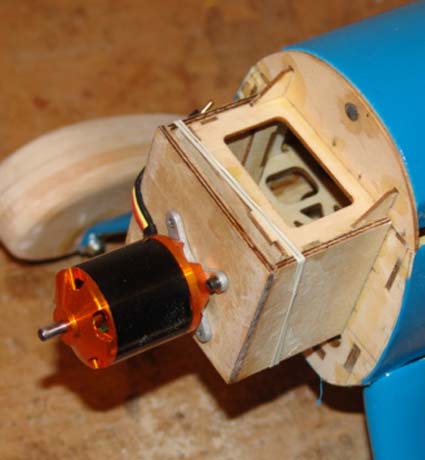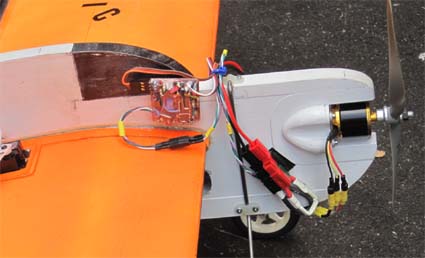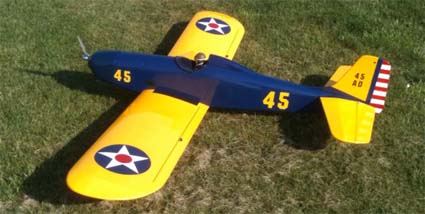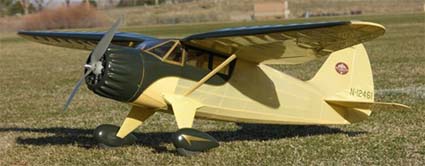 |
Flying High With Electric Power!
The Ampeer ON-LINE!
Fly the Future - Fly Electric! |
Site Table of Contents
| President: | Vice-President: | Secretary/Treasurer: |
| Ken Myers | Richard Utkan | Rick Sawicki |
| 1911 Bradshaw Ct. | 240 Cabinet | 5089 Ledgewood Ct. W. |
| Commerce Twp., MI 48390 | Milford, MI 48381 | Commerce Twp., MI 48382 |
| (248) 669-8124 | (248) 685-1705 | 248.685.7056 |
 | ||
| Board of Directors: | Board of Directors: | Ampeer Editor |
| David Stacer | Jack Lemon | Ken Myers |
| 16575 Brookland Blvd. | 8908 Sandy Ridge Dr. | 1911 Bradshaw Ct. |
| Northville, MI 48167 | White Lake, MI 48386 | Walled Lake, MI 48390 |
| 248.924.2324 | 248.698.4683 | 248.669.8124 |
| Mailed Ampeer subscriptions are no longer available | ||
| The Next Flying Meeting:
Date: Saturday Aug. 21 Time: 10:00 a.m. Place: The Midwest RC Society 7 Mi. field | ||
|
By Ken Myers
I received my new Scorpion SII-3026-710 in November and immediately checked the Kv using the drill press method.
APC 11x5.5E 12.25v, 19.5 amps, 8554 RPM
The data was input into the Drive Calculator program. Drive Calculator indicates that the Kv of this motor, which is supposed to be about 710, is 770.8. I would call this Kv discrepancy an anomaly except that motor data was already in Drive Calculator as tested by www.litronics2000.de (www.elektromodellflug.de)/ Gerd Giese. That data showed a Kv of 764.7. For me, the Kv of this motor is 770. This is the very first time that I'd found this large of a discrepancy in Scorpion data. I was surprised.
XOAR 13x6 beech wood sport - wt. 24.8g;
XOAR 13x7 beech wood sport - wt. 31.4g;
Master Airscrew 13x6 beech wood - wt. 26.4g:
I did not retest the APC 13x6.5E. It was tested last in the load tests, so the volts and amps would be a little higher than noted, along with the RPM. At 7600 RPM the pitch speed would be 46.8 mph. It weighs 26.05g.
APC 13x8E - wt. 29.95g;
Weights and measures:
I have been extremely pleased with Scorpion products, and this motor is no exception. I continue to highly recommend them to anyone who wishes to purchase a nicely produced motor from a company that stands behind their products.
THE BATTERY DISCHARGE MONITOR (BDM) - REVISITED
The Battery Discharge Monitor (BDM) is an add-on device for use with Li-Poly motor batteries for the specific purpose of precluding "over draining" these packs. This idea was previously offered in the Ampeer a few years ago. However, since Li-Poly technology and application have both expanded a lot since then, it seemed a good time to share this idea again.
In recent times more and more suppliers are encouraging not draining more than 80% of pack capacity. In other words, leave 20% of charge in the pack at end of flight. But what is "pack capacity" and how is it determined? I've not seen a convincing answer. In my case, I'm taking the printed label capacity as tongue-in-cheek gospel and going with that number for now. But that does not answer the remaining obvious challenge: while in the air (or anyplace else!) how does one know when the pack is down to 20% of the label capacity?
Enter the BDM. The Ampeer briefly discussed the BDM idea a few years ago following the LCDC article. The idea is to monitor the actual ampere hours (coulombs) taken from a pack in flight - no matter the plane, flying style, duration, cell count, or anything else, and upon reaching some predetermined Ah value provide an "alert" to the pilot. The only thing that has changed since that earlier Ampeer discussion is that now I have several more BDM's in use some of which are smaller in size than the originals. What has remained the same is that the BDM idea continues to work without fail. |
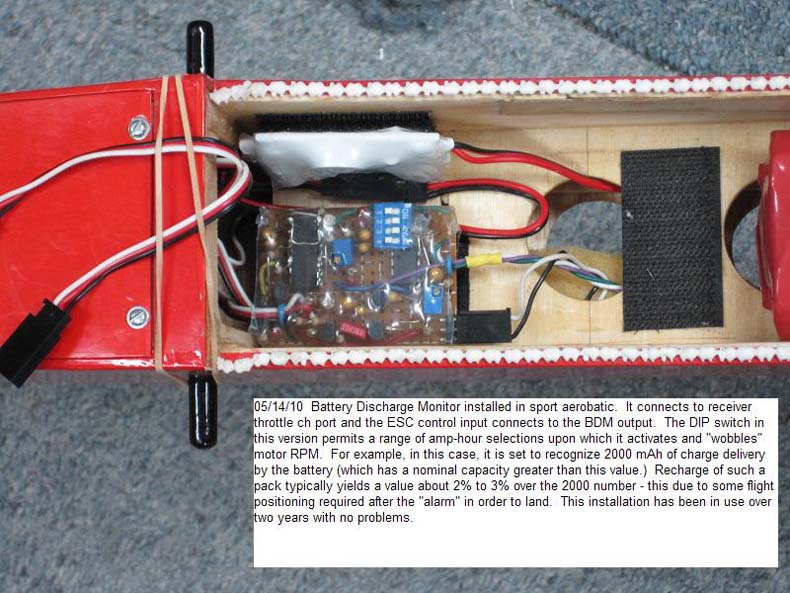
|
Most of my active fleet is now outfitted with BDM's with more installations on the way. In the case of those planes that use the 2.2Ah packs, I have them set to "alert" at about 1.6Ah. The alert I use is a "wobbling motor RPM". (A friend has tried sounding a piezo beeper and / or flashing a very bright LED instead.) But why 1.6Ah for a 2.2Ah pack - isn't that a bit conservative?
|
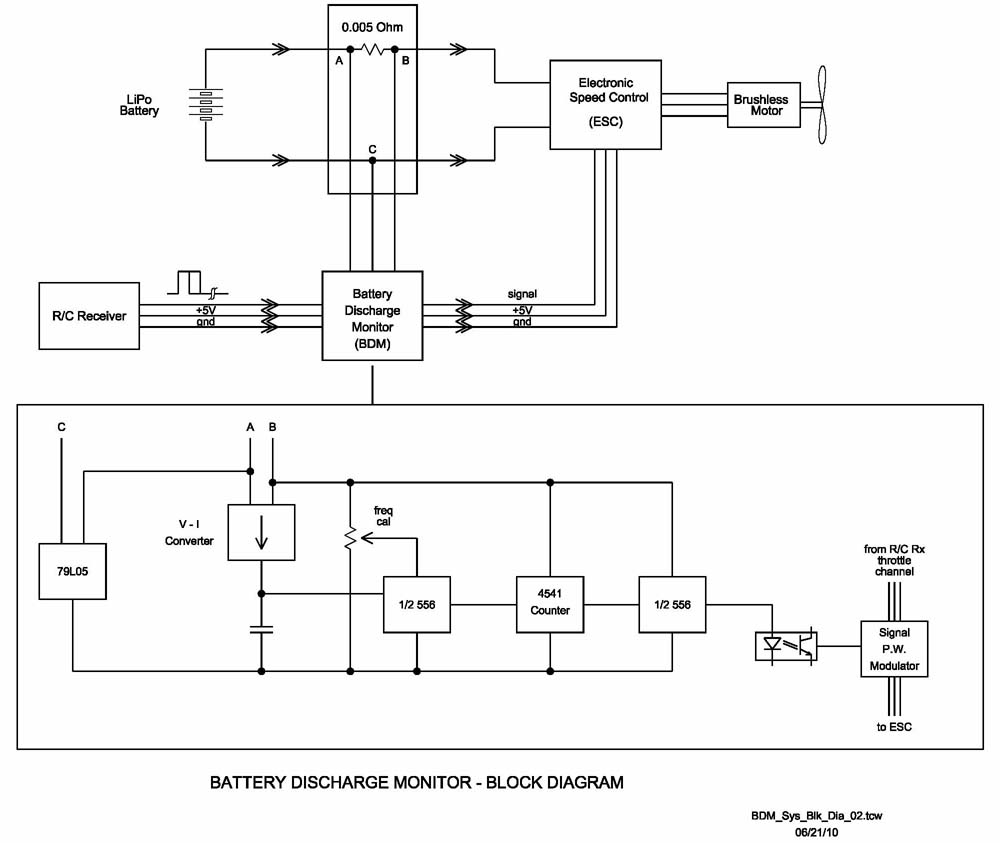
|
I've included the block diagram of the BDM concept and some photos. Admittedly my assemblies are a bit crude - being built with analog technology on hole-board with discreet (leaded) components. I know the idea could be built much better / smaller with SMD techniques employing microprocessor control that would allow programmability for a wide range of "alert" value settings. Ultimately, I think the BDM idea would be best realized as a functional part of the ESC itself. This would result in the most compact / lightest installation overall and become just another easy ESC parameter to program. Now a brief "how it works" - Current out of the battery is sensed with the shunt resistor (I use 0.005 ohms) and the resulting voltage drop is routed to an op-amp / voltage-to-current converter circuit. This circuit outputs a much smaller, directly proportional current to charge a timing capacitor in an astable "555 timer" circuit. This results in a local clock frequency proportional to battery current - the more current the higher the clock rate. This varying astable output is then routed to a counter IC which, when the count is "full", outputs a gate signal. Thus, it takes both battery current and time (ampere-hours) to reach this point. The latter initiates another astable clock - this one a slow square wave of about 1 Hz. This signal in turn modulates the Rx to ESC control pulse width thereby varying the motor RPM. Summarizing, now after a few years of flying varied approaches to guarding Li-Poly batteries from over discharge (and sometimes failing!), I'm satisfied nothing is as effective as using coulomb count. It is in every way at least as good as the pack label capacity statement and has never failed me. For those who may like to experiment with the BDM idea/design, I can email some .pdf circuit details and you can give it a go. I do not have a step by step "how to build" document - you're on your own with this aspect, and so I'd recommend this for "more experienced and better equipped" experimenters. In any case, please feel free to let me or Ken Myers at the Ampeer in on your thoughts about, and reaction to, the BDM idea. And if you think it's a good idea, also go lean on some ESC manufacturers. But no matter what, as should be obvious, I'm sold on the Battery Discharge Monitor idea and I intend to keep using it! Cordially,
Complete coverage of the 2010 Mid-Am will be in the September 2010 Issue of the Ampeer |
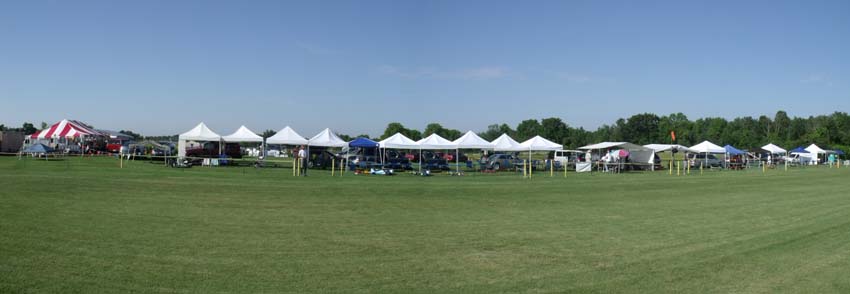
Saturday Morning at the Mid-Am
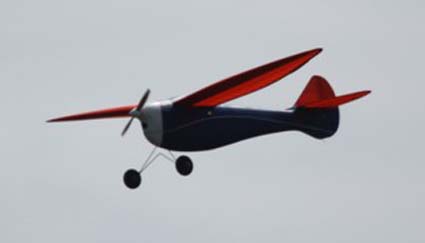
One of the great planes flying at the 2010 Mid-Am Comparing Glow Engines to Electric Power - Again
There is really no good answer to the question "How does a glow 2-stroke or 4-stroke or even a gasoline engine compare to an electric power system?" The two types of power systems are completely different in how they "create/generate" a given plane's performance and the user's perception of that performance. For more information on this see "Part 2: How Electric Power Systems 'Create' Usable Power Compared to Glow and Gas engines" in the upcoming October 2010 Ampeer.

Table 1: Conversion Table The 46 LA as an Example According to the Conversion Table, an electric power system with about 675 watts in should be equivalent to a sport 0.46 cu.in. displacement engine, which this engine is, and about 900 watts in for a performance 0.46. If the electric power system has a system efficiency of 75%, not an uncommon system efficiency for this size system, then the power out in watts would be about 506 watts or about 0.68 horsepower (hp) for a sport engine and 675 watts or about 0.90 hp for a performance engine.

Table 2: Andrew's Data According to the Conversion Table, an electric power system with about 1425 watts in should be equivalent to a sport 0.95 cu.in. displacement 2-stroke motor, and about 1900 watts in for a performance 0.95, which this engine is. With a 75% efficient electric power system, then the power out in watts would be about 1069 watts or about 1.43 horsepower (hp) for a sport engine and 1425 watts or about 1.91 hp for a performance engine.
 The data illustrates that the 'rule of thumb' is quite reasonable. The 'rule of thumb' for the sport 46 LA suggests 0.46 * 1500 equals 690 watts in, and that certainly puts the user of the rule in the ballpark. The performance 95AX is 0.95 * 2000 = 1900 watts in. Again, the data confirms the 'rule of thumb'. Sometimes glow fliers ask electric fliers what their electric power system is equivalent to in the glow 2-stroke world. You can use the table that shows the 2-stroke to electric equivalents in reverse, or simply use the multipliers as divisors.
Using another 'rule of thumb', to find the 4-stroke glow equivalent to a 2-stroke glow engine, multiply the 2-stroke displacement by 1.5. The multiplier of 1.5 comes from the old AMA rules when 2-stroke engine size was specified for an event and someone chose to use a 4-stroke. Today's 4-strokes are more powerful, so the resulting multiplier would be smaller, but for our purposes it will do just fine. A 0.29 cu.in. displacement 2-stroke, like the sport Enya "29", times 1.5 is equivalent to a 0.435 cu.in. 4-stroke. That is right between a 40 and 45/46 4-stroke. An O.S. FS-40 Surpass 4-stroke can swing up to a 12x6 prop, according to the data on Tower Hobbies Web site. When going glow 4-stroke on the Super Stearman that could be a usable choice. The previous example demonstrates how 4-stroke engines are more closely akin to electric power systems in how they "create" a given plane's performance and the user's perception of that performance. It also illustrates the relationship of a 4-stroke glow engine to the power in of an electric power system. Did you see the relationship?
Here are a few predicted examples of some classic, and not so classic glow planes, that might be converted to an electric power system using the multiply by 1000 rule of thumb for 4-stroke engines: Sig Astro Hog 4-stroke recommendation .60 to .80 equivalent to 600 watts in to 800 watts in
While all of the example planes would probably "fly" with the lower of the two watts in numbers, I believe that most modelers would be happier with the results obtained by using the higher of the watts in numbers.
Rich Sievert of the Midwest RC Society has had an Astro Hog for many, many years now. It has well over 500 flights on it. He actually logs every flight. He converted it to electric power and the most recent 33 flights have been with the electric power system. It is a true conversion spending its early life with various internal combustion engines powering it.
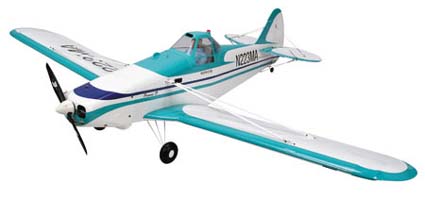 The March 2010 issue of R/C Model Aeroplane has a review of the Hangar 9 Piper Pawnee 40 ARF crop duster by David Ashby. (starting on p.14) David chose to power it with the recommended E-flite Power 46 outrunner, Castle Creations 60 amp ESC and a 4S 3700mAh Li-Poly battery turning some type of 14x6 prop. He states that the watts in for his 8 lb. model is approximately 700 at about 46 amps. 700 watts in, based on my statements, suggests a .70 cu.in. 4-stroke or .46 cu.in. 2-stroke.
To select a power system for a glow conversion, use the manufacturer's recommended 4-stroke displacement, drop the decimal point and add a zero to the right. If the manufacturer does not give a 4-stroke recommendation, multiply the 2-stroke recommendation by 1.5, drop the decimal point and add a zero to the right. Those numbers represent the approximate watts in for somewhat equivalent power. Stinson SR-10 Modifications to SR-7/8
Hi Ken, I've been following your PT-17 conversion, looks great. I am currently building Pat Tritles's recent Stinson SR-10 Reliant short kit and have a build thread going in E-Zone Scale Electric Plane forum. www.rcgroups.com/forums/showthread.php?t=1236193 I will modify the forward cabin/windshield structure to the SR-7/8 version and will add a number of scale cabin details including gray poster board paneling, seats, instrument panel; 3-spoke "steering wheels" and a pilot thrown in for good measure. The model will weigh about 32 ounces, wingspan is around 58 inches, has flaps, requires six small servos and a switching type BEC. This will be my first model with flaps.
Gary Gullikson |
To Reach Ken Myers, you can land mail to the address at the top of the page. My E-mail
address is:
KMyersEFO@theampeer.org
EFO WEBsite
